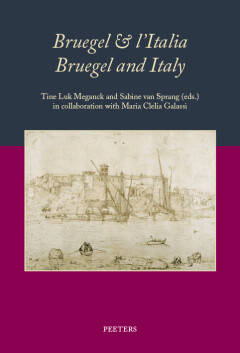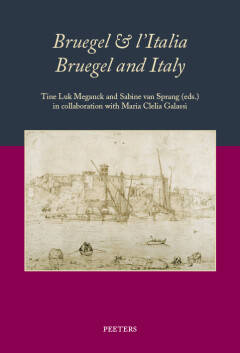
- Afhalen na 1 uur in een winkel met voorraad
- Gratis thuislevering in België vanaf € 30
- Ruim aanbod met 7 miljoen producten
- Afhalen na 1 uur in een winkel met voorraad
- Gratis thuislevering in België vanaf € 30
- Ruim aanbod met 7 miljoen producten
Zoeken
Bruegel & l'Italia / Bruegel and Italy
Proceedings of the International Conference Held in the Academia Belgica in Rome, 26-28 September 2019
Meganck Tine Luk
€ 110,00
+ 220 punten
Omschrijving
Pieter Bruegel the Elder is best known for his peasant and winter scenes, archetypal images of the Low Countries, but his masterpieces always manage to transcend the local. A defining element in his hybrid landscapes are the Alpine rock formations he observed on his way to or return from Italy. Bruegel travelled to the peninsula around 1552, and his sojourn lasted about two years. Though remarkably little of his artistic production in Italy has been preserved, later compositions demonstrate that Bruegel must have journeyed to Rome, and then as far as Naples and Messina. The purpose of this book is to reassess Bruegel's encounter with Italy within a broad cultural-historical context and in light of recent scholarship. Communication between Italy and the Low Countries was intense during Bruegel's time, as were artistic, political, and economic relations. While Italo-Netherlandish ties interconnected Bruegel's world on multiple levels, Bruegel's relationship with Italy has mostly been viewed from the perspective of his individual travels. It has often been observed that, unlike many of his fellow artist-travellers, no copies after antique or modern Italian artworks by his hand are known, and that the impact of Bruegel's encounter with Italy is not immediately evident from his work. Bruegel and Italy/Bruegel e l'Italia rephrases this question: Why, then, Bruegel did travel to Italy? To formulate potential answers, its authors look not only at the master and his work but also consider the cultural and artistic exchange between Italy and the Low Countries before, during, and following Bruegel's Italian travels. In doing so, they trace the conditions, traditions, and networks that shaped and motivated Bruegel's dialogue with Italy, opening new avenues in the study of this notoriously under-documented master.
Specificaties
Betrokkenen
- Auteur(s):
- Uitgeverij:
Inhoud
- Aantal bladzijden:
- 245
- Taal:
- Engels
- Reeks:
- Reeksnummer:
- nr. 3
Eigenschappen
- Productcode (EAN):
- 9789042950306
- Verschijningsdatum:
- 8/05/2023
- Uitvoering:
- Paperback
- Formaat:
- Trade paperback (VS)
- Afmetingen:
- 170 mm x 250 mm
- Gewicht:
- 326 g

Alleen bij Standaard Boekhandel
+ 220 punten op je klantenkaart van Standaard Boekhandel
Beoordelingen
We publiceren alleen reviews die voldoen aan de voorwaarden voor reviews. Bekijk onze voorwaarden voor reviews.











